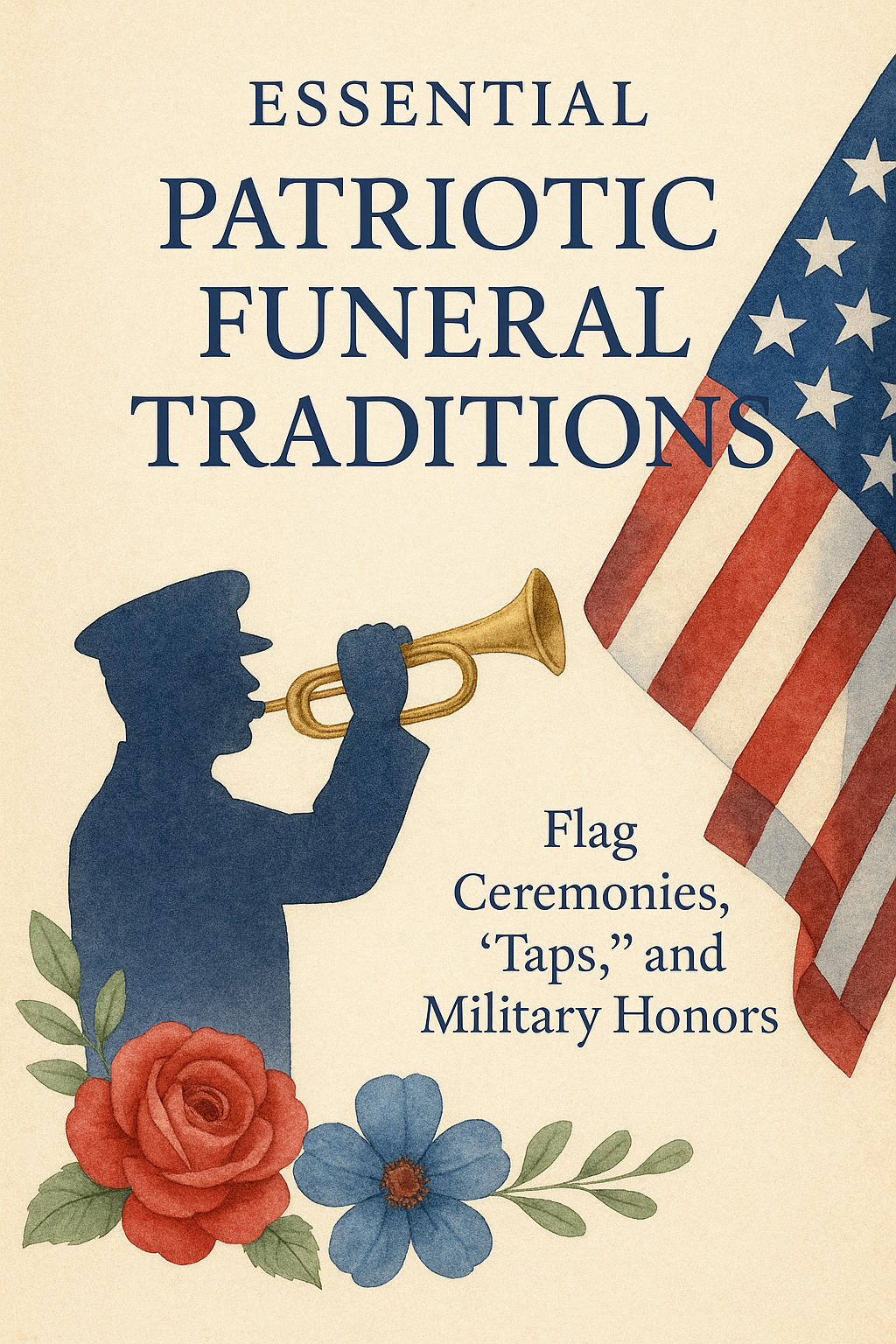We may earn money or products from the companies mentioned in this post. As an Amazon Associate I earn from qualifying purchases. Disclosure of Material Connection: Some of the links in this post may be "affiliate links." This means if you click on the link and purchase an item, I will receive an affiliate commission.
Patriotic funerals are a profound way to honor the lives of veterans, service members, and American heroes. These ceremonies are rich with tradition, symbolism, and deep respect for those who have served their country. Whether you are planning a funeral for a loved one who was a member of the armed forces or simply wish to incorporate patriotic elements into a memorial, understanding these essential patriotic funeral traditions will help you create a meaningful and memorable tribute.
Essential Patriotic Funeral Traditions: Flag Ceremonies, “Taps,” and Military Honors
Why Patriotic Funeral Traditions Matter
Patriotic funeral traditions connect us to the values of service, sacrifice, and national pride. They provide comfort to grieving families, foster a sense of unity, and ensure that the legacy of the deceased is honored with the dignity they deserve. These rituals are not just formalities—they are powerful gestures of gratitude and remembrance.

The American Flag in Patriotic Funerals
History and Meaning
The American flag is the most recognizable symbol of a patriotic funeral. Draping the flag over the casket or displaying it near the urn signifies the nation’s appreciation for the individual’s service and sacrifice.
-
Symbolism: The flag represents the freedoms and values the deceased helped protect.
-
Tradition: The custom dates back to the Napoleonic Wars and became standard practice for U.S. military funerals during the Civil War.
Proper Flag Placement
-
Casket: The blue field of stars (the union) is placed at the head and over the left shoulder.
-
Urn: The flag is neatly folded and displayed beside the urn.
-
Never let the flag touch the ground.
The Flag Folding Ceremony
One of the most moving moments in a patriotic funeral is the flag folding ceremony. Performed by an honor guard, the flag is folded into a triangle, symbolizing the tri-cornered hats worn by Revolutionary War soldiers.
-
Thirteen folds: Each fold has symbolic meaning, representing life, belief in eternal life, honor, and remembrance.
-
Presentation: After folding, the flag is presented to the next of kin with a statement of gratitude, such as:
“On behalf of the President of the United States, the United States Armed Forces, and a grateful nation, please accept this flag as a symbol of our appreciation for your loved one’s honorable and faithful service.”
The Playing of “Taps”
Origins and Significance
“Taps” is a 24-note bugle call that has become synonymous with military funerals and memorials.
-
History: Composed during the Civil War, “Taps” was originally a signal to extinguish lights. Its haunting melody is now a final farewell to those who have served.
-
Meaning: The notes of “Taps” evoke reflection, gratitude, and solemnity.
When and How “Taps” Is Performed
-
Timing: “Taps” is typically played after the flag folding and presentation.
-
Performance: Ideally, a live bugler plays “Taps.” If not available, a high-quality recording is used.
-
Etiquette: Attendees stand, veterans salute, and civilians place their right hand over their heart.
The Rifle Salute and Other Military Honors
The Three-Volley Salute
The three-volley rifle salute is a traditional military honor, symbolizing respect and farewell.
-
History: This tradition dates back to European battlefields, where fighting paused to remove the dead, and three volleys signaled a return to battle.
-
Who Performs: A firing party of 3-7 service members.
-
How It Works: The party fires three volleys in unison, typically with rifles.
The 21-Gun Salute
-
Reserved for: Heads of state, high-ranking officers, and national heroes.
-
Not to be confused with the three-volley salute, which is standard for most veterans.
Honor Guard and Color Guard
-
Honor Guard: Uniformed service members who perform ceremonial duties, including flag folding and carrying the casket.
-
Color Guard: Presents and retires the national and service flags during the ceremony.
Additional Patriotic Traditions
Military Band and Procession
-
Live music: Military bands may play patriotic hymns, the national anthem, or the service branch’s song.
-
Procession: The casket or urn may be escorted by military personnel in a formal procession.
Display of Medals and Service Insignia
-
Memory Table: Display medals, ribbons, badges, and personal memorabilia.
-
Uniform: The deceased may be dressed in their uniform or have it displayed nearby.
The “Missing Man” Formation
-
Aviation Tribute: In Air Force funerals, a formation of aircraft flies overhead, with one plane departing to symbolize the fallen.
-
Symbolism: Represents the loss of a comrade and the void left behind.
How to Arrange Military Honors
Who Is Eligible?
-
Veterans: Most honorably discharged veterans are eligible for military funeral honors.
-
Active Duty: All active duty service members.
-
Retirees: Military retirees and some reservists.
How to Request Honors
-
Contact the Funeral Director: They can coordinate with the Department of Defense or local veterans’ organizations.
-
Provide Documentation: You will need the DD Form 214 (Certificate of Release or Discharge from Active Duty).
-
Arrange in Advance: Request honors as soon as possible to ensure availability.
What to Expect
-
Minimum Honors: At least two uniformed service members, the playing of “Taps,” and flag folding/presentation.
-
Additional Honors: Rifle salute, color guard, and military band, depending on eligibility and resources.
Etiquette for Attendees
Dress Code
-
Respectful attire: Dark, conservative clothing is appropriate.
-
Veterans: May wear their uniforms or service pins.
Conduct During Honors
-
Standing: Everyone should stand during the flag ceremony, “Taps,” and rifle salute.
-
Saluting: Veterans in uniform salute; civilians place their right hand over their heart.
-
Silence: Maintain silence during “Taps” and other honors.
Incorporating Patriotic Traditions for Civilians
While official military honors are reserved for veterans and service members, anyone can incorporate patriotic elements into a funeral:
-
Display the American flag: On the casket, near the urn, or as part of the décor.
-
Play patriotic music: “God Bless America,” “America the Beautiful,” or the national anthem.
-
Use red, white, and blue flowers: In arrangements or wreaths.
-
Share stories of service: Invite guests to share memories of the deceased’s patriotism.
Frequently Asked Questions About Patriotic Funeral Traditions
Can any family request a flag for a funeral?
Only veterans, active duty service members, and some public servants are eligible for an official burial flag from the VA. Civilians can purchase a flag for display.
Is the rifle salute required?
No, it is optional and based on the family’s wishes and the deceased’s eligibility.
How do I find a live bugler for “Taps”?
Ask your funeral director or visit organizations like Bugles Across America.
Conclusion
Patriotic funeral traditions are a powerful way to honor a life of service and sacrifice. From the flag-draped casket to the playing of “Taps” and the rifle salute, each ritual is steeped in history and meaning. By understanding and incorporating these essential traditions, you ensure that your loved one’s legacy is celebrated with the respect and gratitude they deserve.
Pin this guide for later, or share it with someone planning a patriotic funeral. For more inspiration.
Honoring service. Celebrating sacrifice. Preserving the legacy of our American heroes.


